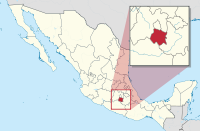
Photo from wikipedia
It has long been established that phytoplasma infection is the cause of the free-branching phenotype in poinsettia. However, relatively limited is known about the ecology of the pathogen in planta.… Click to show full abstract
It has long been established that phytoplasma infection is the cause of the free-branching phenotype in poinsettia. However, relatively limited is known about the ecology of the pathogen in planta. The present study evaluated the infection pattern of poinsettia branch-inducing phytoplasma (PoiBI) and its association with poinsettia phenotype during cutting propagation. The presence of this pathogen in the poinsettia variety 'Luv U Pink' was determined using polymerase chain reaction (PCR) and sequence analysis. The infection density of PoiBI in distinct tissue types of different plant segments were then determined using quantitative PCR coupled with plasmid-based standard curves. Both vegetative stage and flowering stage plants were tested. The results showed that despite being considerably variable among plants, the infection densities of PoiBI tend to be higher in source leaves located in the lower parts of the plant. The densities were consistently lower in tissues located at the top of the plants, regardless of the tissue type. Analysis on the infection densities among samples collected from six stock plants used in commercial production also revealed significantly different levels of PoiBI load. An association between PoiBI infection density in the stock plants and the level of branching in cutting-propagated plants (derived from the stock plants) was also observed; stock plants with low infection densities tend to produce smaller proportions of plants exhibiting higher degrees of branching both before and after pinching. These data suggest that uneven distribution of PoiBI within and among stock plants may lead to the production of cuttings with variable phytoplasma densities, which may in turn affect the phenotypic uniformity of the plants produced. Overall, findings from the present work add to the understanding of PoiBI's ecology and could provide implications to commercial poinsettia production.
Journal Title: Plant disease
Year Published: 2020
Link to full text (if available)
Share on Social Media: Sign Up to like & get
recommendations!